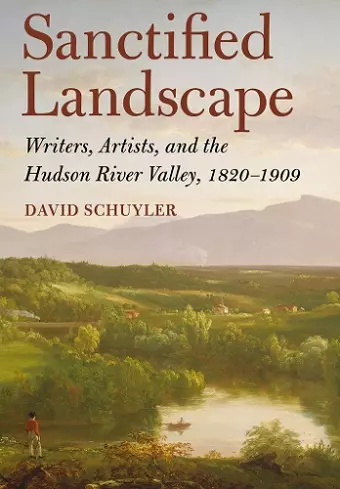Sanctified Landscape
Writers, Artists, and the Hudson River Valley, 1820–1909
Format:Hardback
Publisher:Cornell University Press
Published:6th Apr '12
Currently unavailable, and unfortunately no date known when it will be back

The Hudson River Valley was the first iconic American landscape. Beginning as early as the 1820s, artists and writers found new ways of thinking about the human relationship with the natural world along the Hudson. Here, amid the most dramatic river and mountain scenery in the eastern United States, Washington Irving and James Fenimore Cooper created a distinctly American literature, grounded in folklore and history, that contributed to the emergence of a sense of place in the valley. Painters, led by Thomas Cole, founded the Hudson River School, widely recognized as the first truly national style of art. As the century advanced and as landscape and history became increasingly intertwined in the national consciousness, an aesthetic identity took shape in the region through literature, art, memory, and folklore—even gardens and domestic architecture. In Sanctified Landscape, David Schuyler recounts this story of America’s idealization of the Hudson Valley during the nineteenth and early twentieth centuries.
Schuyler’s story unfolds during a time of great change in American history. At the very moment when artists and writers were exploring the aesthetic potential of the Hudson Valley, the transportation revolution and the rise of industrial capitalism were transforming the region. The first generation of American tourists traveled from New York City to Cozzens Hotel and the Catskill Mountain House in search of the picturesque. Those who could afford to live some distance from jobs in the city built suburban homes or country estates. Given these momentous changes, it is not surprising that historic preservation emerged in the Hudson Valley: the first building in the United States preserved for its historic significance is Washington’s Headquarters in Newburgh. Schuyler also finds the seeds of the modern environmental movement in the transformation of the Hudson Valley landscape.
Richly illustrated and compellingly written, Sanctified Landscape makes for rewarding reading. Schuyler expertly ties local history to national developments, revealing why the Hudson River Valley was so important to nineteenth-century Americans—and why it is still beloved today.
In his capable and congenial history, David Schuyler, a humanities and American studies professor at Franklin and Marshall College, reminds us that the dance of change and permanence itself has been a constant throughout Catskill and Hudson Valley history.
-- John Rowen * Kaatskill Life *Over the past two decades or so, David Schuyler has established himself as one of the nation's preeminent students of American landscape and planning history. Whether in dealing with the transformative nature of the forces that created urban landscapes or assessments of the fathers of landscape architecture in America, namely Frederick Law Olmstead and Andrew Jackson Downing, Schuyler’s work has fashioned for us a deeper understanding and appreciation for the events, personalities, and forces that have made our environment what it is.... This is a fine and handsome book with lusciously reproduced paintings,wonderful reproductions of drawings and plans, and strong photographs. The quality reflects what university presses do better than most. In an era when many university presses are facing closure or are being downsized, a book of this nature is argument enough to embrace university presses for what they are: national treasures. And this book is a book about a national treasure itself, the mighty Hudson River. Thanks to David Schuyler and the Cornell University Press!
* Environmental History *Schuyler has fashioned an absorbing account of the cultural milieu in which the Hudson Valley, a landscape of discrete villages, towns, and estates, was transformed into an iconic American region.... He adroitly foregrounds an abundant selection of contemporary sources testifying to the passionate sense of place these men exhibited in their professional and personal lives, as well as the influence most exerted, at least for a time, on the nation's aesthetic taste. Linking the Hudson Valley to early efforts of historic preservation and environmentalism, Schuyler commendably avoids the usual good-versus-evil narrative. The author's own sense of place is evident in illustrations and maps.
* Choi- Winner of Winner of the Herbert H. Lehman Award (New York Ac.
ISBN: 9780801450808
Dimensions: 254mm x 178mm x 20mm
Weight: 907g
224 pages